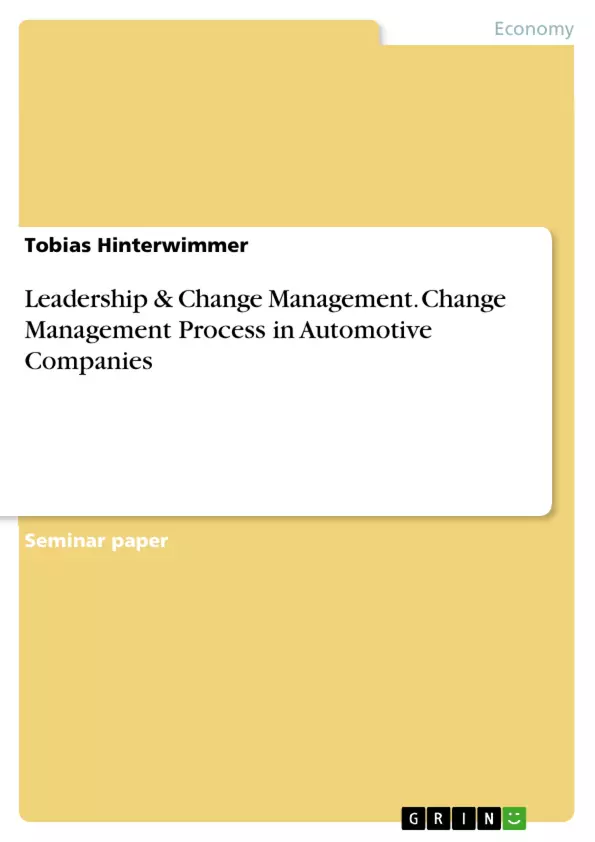The two cornerstones of the term paper are on the one side “Leadership” and on the other side “Change Management”. Leadership is simply the ability to influence others towards joint targets in a way that motivates these others and leads to the desired results. Change Management is rather difficult to describe in one glance. Nonetheless, it is meant to be a process, tool or technique to manage the people side of change in order to achieve a desired outcome cf. (Prosci, no date). What Change Management really depicts is going to be clarified in the course of the term paper.
The following term paper constitutes a critical assessment by the author whether organizational transformations require a well-orchestrated change management program, strong leadership and business acumen. In the following, the outlined theoretical background is going to be applied regarding a case study about the Italian car manufacturer “FIAT”. Thereby, special emphasis will be put on the observed leadership style, underlying complexities and paramount challenges. Ultimately, the last chapter will consist of future recommendations to make the business model more sustainable.
Inhaltsverzeichnis (Table of Contents)
- Introduction
- Driving organizational transformation requires a well-orchestrated change management program capsuled by strong leadership and business acumen – A critical assessment by the author
- Role modeling
- Fostering understanding and conviction
- Reinforcing changes through formal mechanisms
- Developing talent and skills
- Critical evaluation of Fiat’s business model
- Leadership Style
- Underlying Complexities
- Paramount Challenges
- Change Management: future recommendations to make the business model more sustainable
- Conclusion
Zielsetzung und Themenschwerpunkte (Objectives and Key Themes)
This term paper critically analyzes whether organizational transformations require a well-orchestrated change management program, strong leadership and business acumen. It applies the outlined theoretical background to a case study about the Italian car manufacturer "FIAT", focusing on the leadership style, underlying complexities, and paramount challenges observed. Ultimately, the paper presents future recommendations to make the business model more sustainable.
- The importance of strong leadership and business acumen in driving organizational transformations.
- The role of change management in navigating organizational transformations.
- The complexities and challenges faced by Fiat during a period of significant transformation.
- The impact of leadership styles on organizational transformations.
- The importance of dynamic capabilities in achieving sustainable business models.
Zusammenfassung der Kapitel (Chapter Summaries)
The paper begins by introducing the concepts of leadership and change management, highlighting their importance in organizational transformation. It then delves into the critical assessment by the author, emphasizing the need for a well-orchestrated change management program alongside strong leadership and business acumen. This chapter discusses various frameworks and models for successful transformation, including McKinsey's survey findings, the Integrated Transformation Approach, and Kotter's 8-step change model.
The next chapter provides a critical evaluation of Fiat's business model, examining the leadership style of Sergio Marchionne, the underlying complexities, and the paramount challenges the company faced. It analyzes Marchionne's leadership style in relation to theoretical models, exploring its effectiveness in addressing Fiat's specific situation.
The final chapter focuses on future recommendations to make the business model more sustainable. It emphasizes the importance of dynamic capabilities, including adaptive capability, absorptive capability, innovative capability, and networking capability, as key drivers for continuous change management and achieving a sustainable business model.
Schlüsselwörter (Keywords)
This term paper focuses on key concepts such as organizational transformation, leadership, change management, business acumen, dynamic capabilities, and case studies. It uses Fiat as a case study to illustrate the application of these concepts in a real-world scenario.
- Quote paper
- Tobias Hinterwimmer (Author), 2018, Leadership & Change Management. Change Management Process in Automotive Companies, Munich, GRIN Verlag, https://www.grin.com/document/456653



